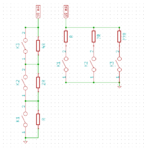kathmandu
Full Member level 5
Hello,
I want to connect the outputs of 6 motion sensors to a uC input through a single wire (along with the 12VDC/GND wires).
The motion sensor's outputs are solid state (normally closed) but I could use some miniature relays to get NO/NC if that helps.
I thought of using a distributed binary weighted resistor network and a current source at the uC side.
This way, every relay (motion sensor) puts a series (or parallel) resistor in circuit thus I'll get different voltage readings at uC side (ADC) depending on what motion sensors (one or multiple) are active.
Is there any other simple way to accomplish this?
I want to connect the outputs of 6 motion sensors to a uC input through a single wire (along with the 12VDC/GND wires).
The motion sensor's outputs are solid state (normally closed) but I could use some miniature relays to get NO/NC if that helps.
I thought of using a distributed binary weighted resistor network and a current source at the uC side.
This way, every relay (motion sensor) puts a series (or parallel) resistor in circuit thus I'll get different voltage readings at uC side (ADC) depending on what motion sensors (one or multiple) are active.
Is there any other simple way to accomplish this?
